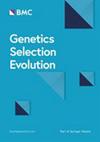The genetic relationship between immune competence traits and micro-genetic environmental sensitivity of weight, fat, and muscle traits in Australian Angus cattle
IF 3.1
1区 农林科学
Q1 AGRICULTURE, DAIRY & ANIMAL SCIENCE
引用次数: 0
Abstract
Improving immune competence (IC) in livestock could reduce the incidence of disease and reliance on the use of antibiotics. In Australian Angus cattle, IC is a measure of an animal’s combined ability to mount antibody and cell-mediated immune responses (AMIR and CMIR). Immune competence may affect traits such as growth and related phenotypes as well as the variability of such phenotypes. However, the genetic relationship between IC and genetic sensitivity to individual environments, measured as micro-genetic environmental sensitivity (GES), is yet to be reported. In this study the genetic parameters of, and correlations between, AMIR or CMIR and micro-GES of live weaning weight (WW) and ultrasound scan records of rib (RIB) and rump (RUMP) fat depth and eye muscle area (EMA) measured between 501 and 900 days of age were estimated. This was accomplished by fitting eight multivariate models with AMIR or CMIR and a double hierarchical generalised linear model on a production trait. The heritabilities were 0.35 and 0.36 for AMIR and CMIR, respectively, and 0.25–0.70 for the production traits. The heritabilities and the genetic coefficient of variation of micro-GES of the production traits ranged from 0.01–0.04 and 18–82%, respectively, and were higher in RIB and RUMP than WW and EMA. The genetic correlations between AMIR and WW, RIB, RUMP, or EMA were -0.35 (SE 0.11), 0.11 (0.12), 0.06 (0.12) and -0.13 (0.12), respectively, while the genetic correlations between CMIR and WW, RIB, RUMP, or EMA were -0.26 (0.12), 0.15 (0.13), 0.16 (0.12) and 0.04 (0.13), respectively. The genetic correlations between IC and micro-GES of WW, RIB, RUMP or EMA were moderately negative to lowly positive and had large SEs rendering them non-significant. The unfavourable genetic correlation between the IC traits and WW supports the hypothesis that mounting an effective immune response can direct resources away from growth when resources are limited. Based on the heritabilities and genetic coefficient of variation of micro-GES, selection to increase uniformity is possible for WW, RIB, RUMP and EMA. The standard errors of the genetic correlations between IC and micro-GES of the production traits were too large to draw any definite conclusions about their relationships. Standard errors are expected to reduce as more IC records are collected.澳大利亚安格斯牛免疫能力性状与体重、脂肪和肌肉性状微遗传环境敏感性的遗传关系
提高牲畜的免疫能力(IC)可以减少疾病的发病率和对抗生素使用的依赖。在澳大利亚安格斯牛中,IC是衡量动物产生抗体和细胞介导的免疫反应(AMIR和CMIR)的综合能力。免疫能力可能影响诸如生长和相关表型以及这些表型的可变性等性状。然而,IC与个体环境的遗传敏感性之间的遗传关系,即微遗传环境敏感性(GES),尚未报道。本研究估计了501 ~ 900日龄断奶体重(WW)、肋(rib)、臀(rump)脂肪深度和眼肌面积(EMA)超声扫描记录的AMIR或CMIR与微ges的遗传参数及其相关性。这是通过拟合8个具有AMIR或CMIR的多元模型和一个生产性状的双层次广义线性模型来完成的。AMIR和CMIR的遗传力分别为0.35和0.36,生产性状的遗传力为0.25 ~ 0.70。生产性状微ges的遗传力和变异遗传系数分别为0.01 ~ 0.04和18 ~ 82%,RIB和RUMP高于WW和EMA。AMIR与WW、RIB、RUMP、EMA的遗传相关分别为-0.35 (SE 0.11)、0.11 (SE 0.12)、0.06 (SE 0.12)、-0.13 (SE 0.12), CMIR与WW、RIB、RUMP、EMA的遗传相关分别为-0.26 (SE 0.12)、0.15 (SE 0.13)、0.16 (SE 0.12)、0.04 (SE 0.13)。WW、RIB、RUMP和EMA的IC与微ges的遗传相关性为中负至低正,se较大,不显著。IC性状与WW之间不利的遗传相关性支持了一种假设,即当资源有限时,建立有效的免疫反应可以引导资源远离生长。基于微基因的遗传力和变异遗传系数,WW、RIB、RUMP和EMA可以通过选择来增加均匀性。生产性状的遗传相关标准误差太大,无法对它们的关系作出明确的结论。随着越来越多的IC记录的收集,标准误差预计会减少。
本文章由计算机程序翻译,如有差异,请以英文原文为准。
求助全文
约1分钟内获得全文
求助全文
来源期刊

Genetics Selection Evolution
生物-奶制品与动物科学
CiteScore
6.50
自引率
9.80%
发文量
74
审稿时长
1 months
期刊介绍:
Genetics Selection Evolution invites basic, applied and methodological content that will aid the current understanding and the utilization of genetic variability in domestic animal species. Although the focus is on domestic animal species, research on other species is invited if it contributes to the understanding of the use of genetic variability in domestic animals. Genetics Selection Evolution publishes results from all levels of study, from the gene to the quantitative trait, from the individual to the population, the breed or the species. Contributions concerning both the biological approach, from molecular genetics to quantitative genetics, as well as the mathematical approach, from population genetics to statistics, are welcome. Specific areas of interest include but are not limited to: gene and QTL identification, mapping and characterization, analysis of new phenotypes, high-throughput SNP data analysis, functional genomics, cytogenetics, genetic diversity of populations and breeds, genetic evaluation, applied and experimental selection, genomic selection, selection efficiency, and statistical methodology for the genetic analysis of phenotypes with quantitative and mixed inheritance.
 求助内容:
求助内容: 应助结果提醒方式:
应助结果提醒方式:


